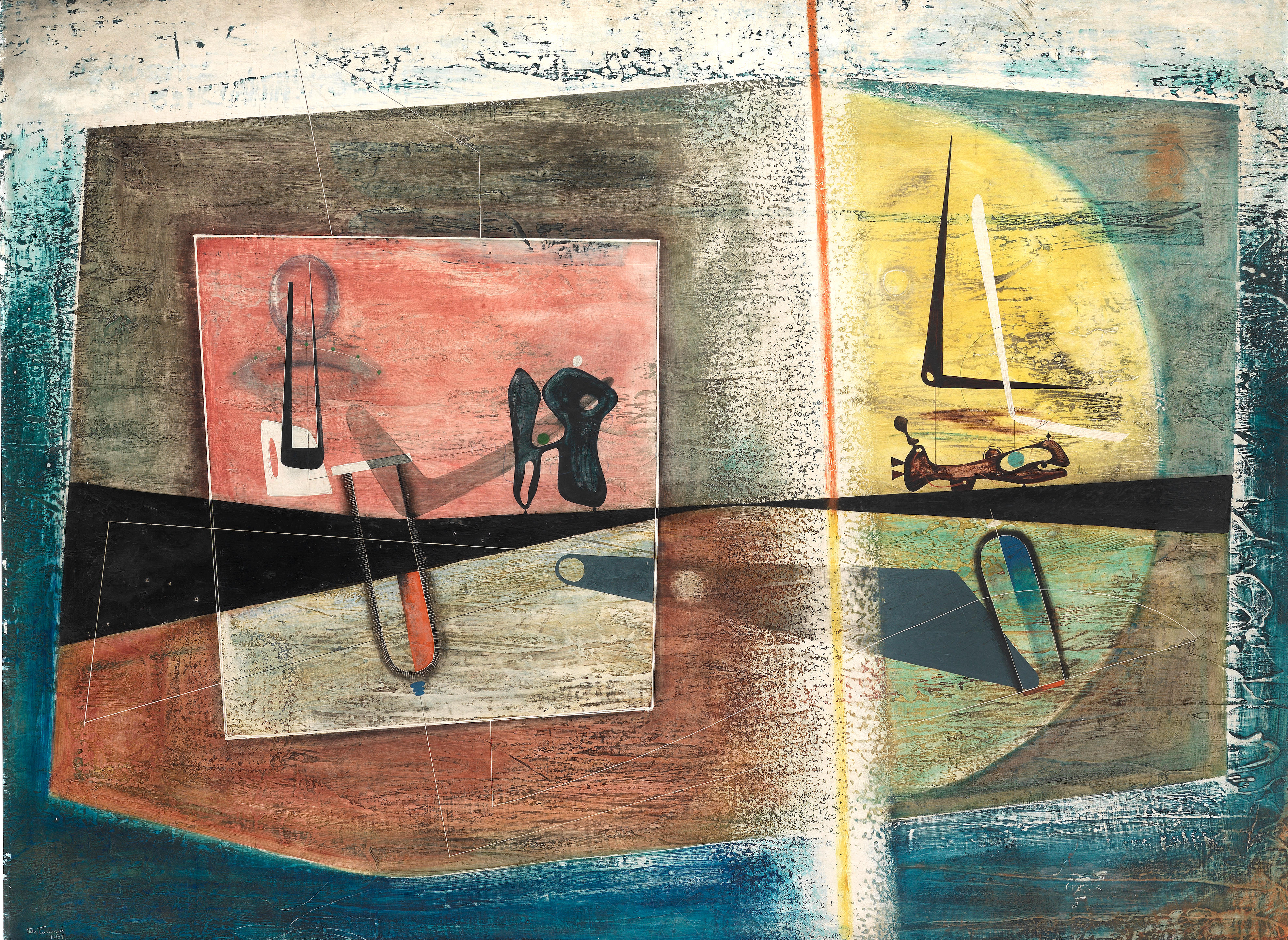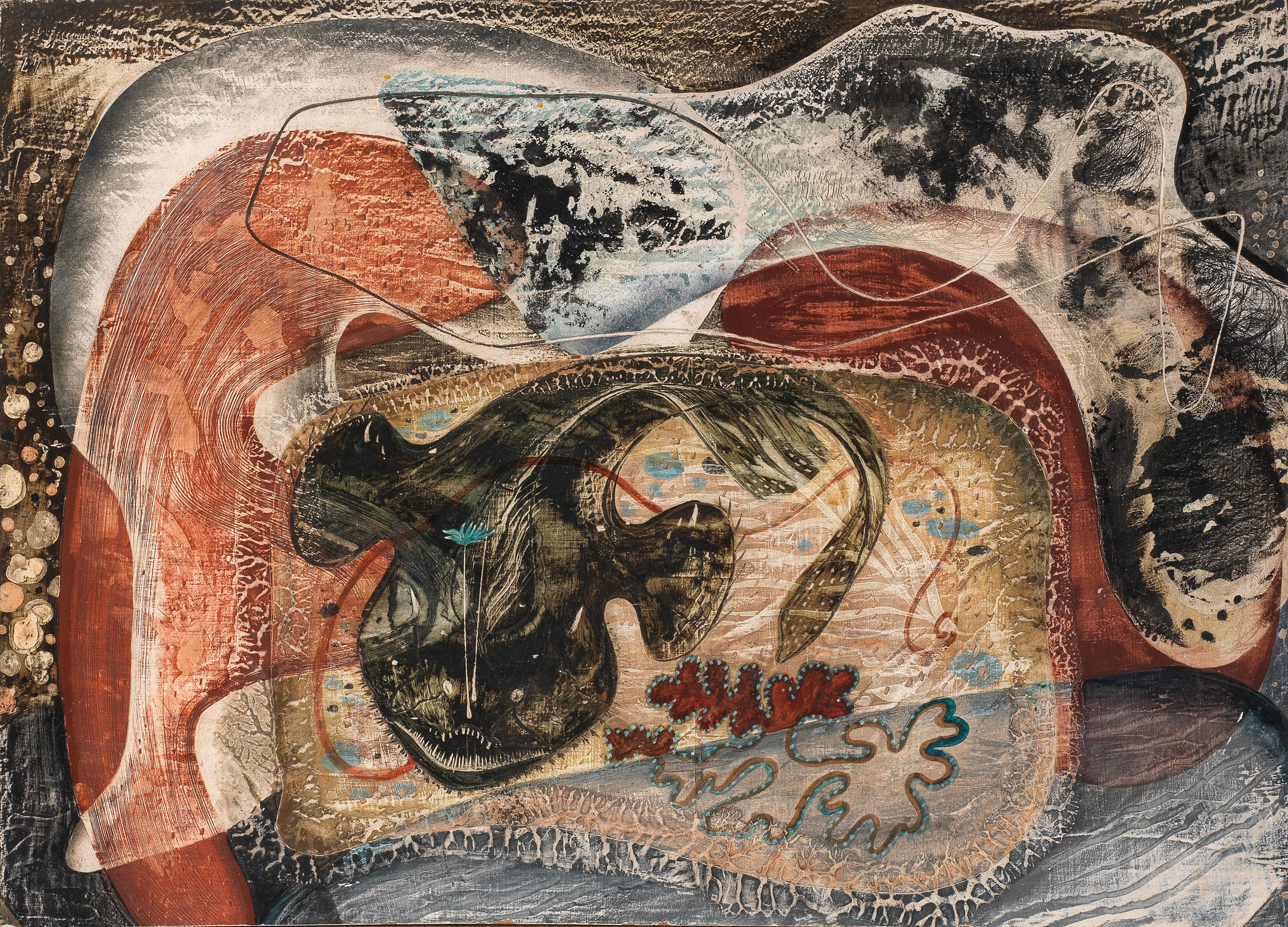John Tunnard A.R.A. (British, 1900-1971)Projection signed and dated 'John Tunnard/42' (lower left) oil and pencil on board 47 x 67.2 cm. (18 1/2 x 26 7/16 in.)FootnotesProvenance Guy Dixon With Leicester Galleries, London, March 1957, where acquired by Michael Stewart Mark James, thence by descent to the present owners Private Collection, U.K. Exhibited London, Council for the Encouragement of Music and The Arts (details untraced) London, Leicester Galleries, The Guy Dixon Collection of Modern Pictures, March 1957, cat.no.28 Tunnard's supreme achievement was his development of a totally unique style, and the present lot is a wonderful example of this. Tunnard took much of his inspiration from the natural world but created a surreal vernacular which was all his own. The atmospheric background of the present work seems to suggest and draw on a number of elements, but ultimately creates an enigmatic space which seems tied to no particular time or place, allowing the central form to float in an otherworldly continuum which has no beginning or end. The varied textures and colours of the background suggest a myriad of natural sources, such as the rough surface of stone or the pitted and shadowed furrows of a lunar landscape, and indeed photos of the moon's surface were found among Tunnard's personal effects in his studio. A pink glow suggests dawn, and streaks of darker blue and white bring to mind the striations of clouds in the sky. As Herbert Read was to comment on Tunnard's work: 'the final effect is that of a dream-landscape, but 'land' must imply more than earth, and more than land and sea. The 'scape' is the limits of imaginative vision'. (Herbert Read, 'The World of John Tunnard', in John Tunnard 1900-1971, exh.cat., Arts Council, 1977, p.54). On this otherworldly landscape is imposed a complex structure which, in highly contrasting black and white, dominates the space. Its forms take their origin from the natural world – they seem to suggest the smooth shapes of bones, or the spikes of jagged leaves – but Tunnard has transposed this into a construction which resists analysis. Arranged into what feels loosely like the outlines of a room, these linear forms hang in space and are duplicated in almost mirror-like format, receding with each new structure, drawing the viewer's eye further and further back into the depths of the composition. Carefully demarcated rectangular shapes hover between these almost-rooms, giving the suggestion of doorways or portals which might give access to these spaces. Always enigmatic, and resisting singular interpretation, Projection is a striking example of the best of Tunnard's mature style. We are grateful to Professor Brian Whitton for his assistance in cataloguing this lot.
John Tunnard A.R.A. (British, 1900-1971)Projection signed and dated 'John Tunnard/42' (lower left) oil and pencil on board 47 x 67.2 cm. (18 1/2 x 26 7/16 in.)FootnotesProvenance Guy Dixon With Leicester Galleries, London, March 1957, where acquired by Michael Stewart Mark James, thence by descent to the present owners Private Collection, U.K. Exhibited London, Council for the Encouragement of Music and The Arts (details untraced) London, Leicester Galleries, The Guy Dixon Collection of Modern Pictures, March 1957, cat.no.28 Tunnard's supreme achievement was his development of a totally unique style, and the present lot is a wonderful example of this. Tunnard took much of his inspiration from the natural world but created a surreal vernacular which was all his own. The atmospheric background of the present work seems to suggest and draw on a number of elements, but ultimately creates an enigmatic space which seems tied to no particular time or place, allowing the central form to float in an otherworldly continuum which has no beginning or end. The varied textures and colours of the background suggest a myriad of natural sources, such as the rough surface of stone or the pitted and shadowed furrows of a lunar landscape, and indeed photos of the moon's surface were found among Tunnard's personal effects in his studio. A pink glow suggests dawn, and streaks of darker blue and white bring to mind the striations of clouds in the sky. As Herbert Read was to comment on Tunnard's work: 'the final effect is that of a dream-landscape, but 'land' must imply more than earth, and more than land and sea. The 'scape' is the limits of imaginative vision'. (Herbert Read, 'The World of John Tunnard', in John Tunnard 1900-1971, exh.cat., Arts Council, 1977, p.54). On this otherworldly landscape is imposed a complex structure which, in highly contrasting black and white, dominates the space. Its forms take their origin from the natural world – they seem to suggest the smooth shapes of bones, or the spikes of jagged leaves – but Tunnard has transposed this into a construction which resists analysis. Arranged into what feels loosely like the outlines of a room, these linear forms hang in space and are duplicated in almost mirror-like format, receding with each new structure, drawing the viewer's eye further and further back into the depths of the composition. Carefully demarcated rectangular shapes hover between these almost-rooms, giving the suggestion of doorways or portals which might give access to these spaces. Always enigmatic, and resisting singular interpretation, Projection is a striking example of the best of Tunnard's mature style. We are grateful to Professor Brian Whitton for his assistance in cataloguing this lot.


.jpg)












Testen Sie LotSearch und seine Premium-Features 7 Tage - ohne Kosten!
Lassen Sie sich automatisch über neue Objekte in kommenden Auktionen benachrichtigen.
Suchauftrag anlegen